Fabrication and Magneto-Optical Properties of Yb2O3 Based Ceramics
Abstract
:1. Introduction
2. Experimental
3. Results and Discussion
3.1. Properties of Yb2O3 Based Powders
3.2. Sintering and Microstructure of (YbxLa1−x)2O3 Ceramics
4. Conclusions
Author Contributions
Funding
Conflicts of Interest
References
- Papp, A.; Harms, H. Magnetooptical current transformer 1: Principles. Appl. Opt. 1980, 19, 3729–3734. [Google Scholar] [CrossRef]
- Zhou, F.Z.; Hu, W.T.; Chen, Y.M.; Li, Z.S.; Shen, L.Q.; Fen, X.Q.; Hu, G.Q.; Yin, Z.W. Compact, magneto-optic Q-switched, neodymium-doped bismuth germinate crystal (Nd:BGO) laser pumped by a laser diode. Appl. Opt. 1995, 34, 4266–4268. [Google Scholar] [CrossRef]
- Scott, G.; Lacklison, D. Magnetooptic properties and applications of bismuth substituted iron garnets. IEEE Trans. Magn. 1976, 12, 292–311. [Google Scholar] [CrossRef]
- Mironov, E.A.; Snetkov, I.; Voitovich, A.V.; Palashov, O.V. Permanent-magnet Faraday isolator with the field intensity of 25 kOe. Quantum Electron. 2013, 43, 740–743. [Google Scholar] [CrossRef]
- Mironov, E.A.; Voitovich, A.V.; Palashov, O.V. Permanent-magnet Faraday isolator with the field intensity of more than 3 tesla. Laser Phys. Lett. 2019, 17, 015001. [Google Scholar] [CrossRef]
- Khazanov, E.A. Compensation of thermally induced polarisation distortions in faraday isolators. Quantum Electron. 1999, 29, 59–64. [Google Scholar] [CrossRef]
- Solomonov, V.I.; Osipov, V.V.; Shitov, V.A.; Maksimov, R.; Lipchak, A.I. Optical properties of ytterbium-doped yttrium oxide ceramics. Phys. Status Solidi 2016, 214, 1600786. [Google Scholar] [CrossRef]
- Snetkov, I.; Mukhin, I.; Palashov, O.; Khazanov, E. Compensation of thermally induced depolarization in Faraday isolators for high average power lasers. Opt. Express 2011, 19, 6366–6376. [Google Scholar] [CrossRef] [PubMed]
- Snetkov, I.; Voitovich, A.V.; Palashov, O.V.; Khazanov, E.A. Review of Faraday Isolators for Kilowatt Average Power Lasers. IEEE J. Quantum Electron. 2014, 50, 434–443. [Google Scholar] [CrossRef]
- Snetkov, I. Features of Thermally Induced Depolarization in Magneto-Active Media with Negative Optical Anisotropy Parameter. IEEE J. Quantum Electron. 2018, 54, 1–8. [Google Scholar] [CrossRef]
- Yakovlev, A.; Snetkov, I.L. Thermal Lens Astigmatism Induced by the Photoelastic Effect in m3m, 432, and 43m Symmetry Cubic Crystals. IEEE J. Quantum Electron. 2020, 56. [Google Scholar] [CrossRef]
- Balabanov, S.S.; Permin, D.A.; Rostokina, E.Y.; Egorov, S.V.; Sorokin, A.A. Sinterability of nanopowders of terbia solid solutions with scandia, yttria, and lutetia. J. Adv. Ceram. 2018, 7, 362–369. [Google Scholar] [CrossRef] [Green Version]
- Ikesue, A.; Aung, Y.L.; Makikawa, S.; Yahagi, A. Total Performance of Magneto-Optical Ceramics with a Bixbyite Structure. Materials 2019, 12, 421. [Google Scholar] [CrossRef] [PubMed] [Green Version]
- Aung, Y.L.; Ikesue, A.; Yasuhara, R.; Iwamoto, Y. Magneto-optical Dy2O3 ceramics with optical grade. Opt. Lett. 2020, 45, 4615. [Google Scholar] [CrossRef] [PubMed]
- Balabanov, S.S.; Demidova, K.; Filofeev, S.; Ivanov, M.; Kuznetsov, D.; Li, J.; Permin, D.A.; Rostokina, E. Influence of Lanthanum Concentration on Microstructure of (Ho1−xLax)2O3 Magneto-Optical Ceramics. Phys. Status Solidi 2020, 257. [Google Scholar] [CrossRef]
- Li, X.; Liu, Q.; Liu, X.; Chen, X.; Wu, L.; Xie, T.; Shi, Y.; Chen, H.; Li, J. Novel (Tb0.99Ce0.01)3Ga5O12 magneto-optical ceramics for Faraday isolators. Scr. Mater. 2020, 177, 137–140. [Google Scholar] [CrossRef]
- Veber, P.; Velazquez, M.; Gadret, G.; Rytz, D.; Peltz, M.; Decourt, R. Flux growth at 1230 °C of cubic Tb2O3 single crystals and characterization of their optical and magnetic properties. CrystEngComm 2015, 17, 492–497. [Google Scholar] [CrossRef]
- Snetkov, I.; Permin, D.A.; Balabanov, S.S.; Palashov, O.V. Wavelength dependence of Verdet constant of Tb3+:Y2O3 ceramics. Appl. Phys. Lett. 2016, 108, 161905. [Google Scholar] [CrossRef]
- Snetkov, I.; Palashov, O. Cryogenic temperature characteristics of Verdet constant of terbium sesquioxide ceramics. Opt. Mater. 2016, 62, 697–700. [Google Scholar] [CrossRef]
- Snetkov, I.; Yakovlev, A.I.; Permin, D.A.; Balabanov, S.S.; Palashov, O.V. Magneto-optical Faraday effect in dysprosium oxide (Dy2O3) based ceramics obtained by vacuum sintering. Opt. Lett. 2018, 43, 4041–4044. [Google Scholar] [CrossRef]
- Yakovlev, A.; Snetkov, I.; Permin, D.; Balabanov, S.; Palashov, O. Faraday rotation in cryogenically cooled dysprosium based (Dy2O3) ceramics. Scr. Mater. 2019, 161, 32–35. [Google Scholar] [CrossRef]
- Furuse, H.; Yasuhara, R. Magneto-optical characteristics of holmium oxide (Ho2O3) ceramics. Opt. Mater. Express 2017, 7, 827–833. [Google Scholar] [CrossRef]
- Balabanov, S.; Filofeev, S.; Ivanov, M.; Kaigorodov, A.; Kuznetsov, D.; Hu, D.; Li, J.; Palashov, O.; Permin, D.; Rostokina, E.; et al. Fabrication and characterizations of holmium oxide based magneto-optical ceramics. Opt. Mater. 2020, 101, 109741. [Google Scholar] [CrossRef]
- Hu, D.; Li, X.; Snetkov, I.; Yakovlev, A.; Balabanov, S.; Ivanov, M.; Liu, X.; Liu, Z.; Tian, F.; Xie, T.; et al. Fabrication, microstructure and optical characterizations of holmium oxide (Ho2O3) transparent ceramics. J. Eur. Ceram. Soc. 2020, 41, 759–767. [Google Scholar] [CrossRef]
- Yakovlev, A.; Balabanov, S.; Permin, D.; Ivanov, M.; Snetkov, I. Faraday rotation in erbium oxide based ceramics. Opt. Mater. 2020, 101, 109750. [Google Scholar] [CrossRef]
- Peters, V. Growth and Spectroscopy of Ytterbium-Doped Sesquioxides. Ph.D. Thesis, University of Hamburg, Hamburg, Germany, 2001. [Google Scholar]
- Yagi, H.; Yanagitani, T. Translucent Rare Earth Oxide Sintered Article and Method for Production Thereof. EP 1,336,596 B1, 24 June 2002. [Google Scholar]
- Balabanov, S.S.; Bykov, Y.; Egorov, S.; Eremeev, A.; Gavrishchuk, E.; Khazanov, E.; Mukhin, I.; Palashov, O.; Permin, D.A.; Zelenogorsky, V. Transparent Yb:(YLa)2O3 ceramics produced by self-propagating high-temperature synthesis and microwave sintering. Opt. Mater. 2013, 35, 727–730. [Google Scholar] [CrossRef]
- Snetkov, I.L.; Mukhin, I.B.; Balabanov, S.S.; Permin, D.A.; Palashov, O.V. Efficient lasing in Yb:(YLa)2O3 ceramics. Quantum Electron. 2015, 45, 95–97. [Google Scholar] [CrossRef]
- Permin, D.A.; Balabanov, S.; Novikova, A.; Snetkov, I.; Palashov, O.; Sorokin, A.; Ivanov, M. Fabrication of Yb-doped Lu2O3-Y2O3-La2O3 solid solutions transparent ceramics by self-propagating high-temperature synthesis and vacuum sintering. Ceram. Int. 2019, 45, 522–529. [Google Scholar] [CrossRef]
- Permin, D.; Balabanov, S.; Snetkov, I.; Palashov, O.; Novikova, A.; Klyusik, O.; Ladenkov, I. Hot pressing of Yb:Sc2O3 laser ceramics with LiF sintering aid. Opt. Mater. 2020, 100, 109701. [Google Scholar] [CrossRef]
- Snetkov, I.; Yasuhara, R.; Starobor, A.V.; Mironov, E.A.; Palashov, O.V.; Starobor, A. Thermo-Optical and Magneto-Optical Characteristics of Terbium Scandium Aluminum Garnet Crystals. IEEE J. Quantum Electron. 2015, 51, 1–7. [Google Scholar] [CrossRef]
- Slezák, O.; Yasuhara, R.; Vojna, D.; Furuse, H.; Lucianetti, A.; Mocek, T. Temperature-wavelength dependence of Verdet constant of Dy2O3 ceramics. Opt. Mater. Express 2019, 9, 2971–2981. [Google Scholar] [CrossRef]
- Flores, J.L.; Ferrari, J.A. Verdet constant dispersion measurement using polarization-stepping techniques. Appl. Opt. 2008, 47, 4396–4399. [Google Scholar] [CrossRef] [PubMed]
- Vojna, D.; Yasuhara, R.; Furuse, H.; Slezák, O.; Hutchinson, S.; Lucianetti, A.; Mocek, T.; Cech, M. Faraday effect measurements of holmium oxide (Ho2O3) ceramics-based magneto-optical materials. High Power Laser Sci. Eng. 2018, 6, 6. [Google Scholar] [CrossRef] [Green Version]
- Starobor, A.; Mironov, E.; Volkov, M.; Karimov, D.; Ivanov, I.; Lovchev, A.; Naumov, A.; Semashko, V.; Palashov, O. Thermal lens investigation in EuF2, PrF3, and Na0.38Ho0.62F2.24 crystals for magnetooptical applications. Opt. Mater. 2020, 99, 109542. [Google Scholar] [CrossRef]
- Babkina, A.; Kulpina, E.; Sgibnev, Y.; Fedorov, Y.; Starobor, A.; Palashov, O.; Nikonorov, N.; Ignatiev, A.; Zyryanova, K.; Oreshkina, K.; et al. Terbium concentration effect on magneto-optical properties of ternary phosphate glass. Opt. Mater. 2020, 100, 109692. [Google Scholar] [CrossRef]
- Yakovlev, A.; Snetkov, I.; Dorofeev, V.; Motorin, S.E. Magneto-optical properties of high-purity zinc-tellurite glasses. J. Non-Cryst. Solids 2018, 480, 90–94. [Google Scholar] [CrossRef]
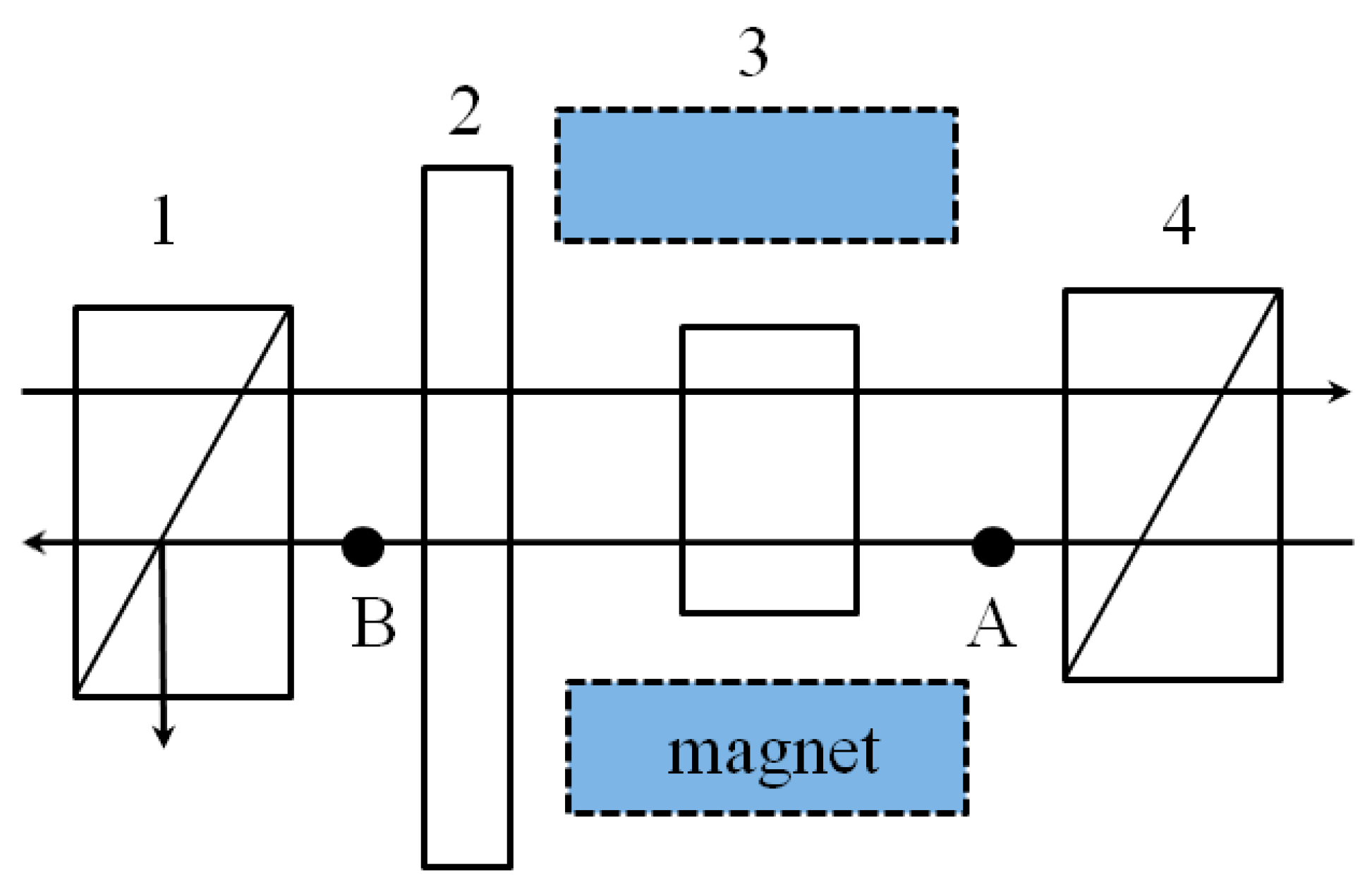
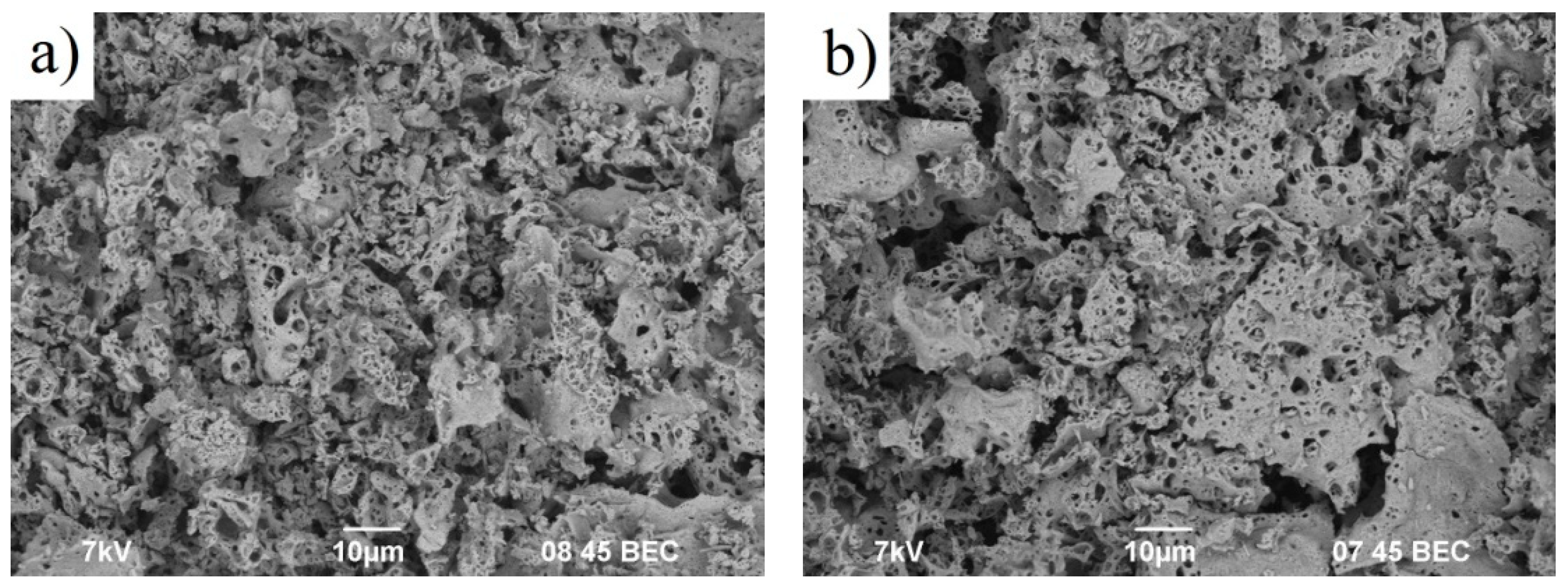
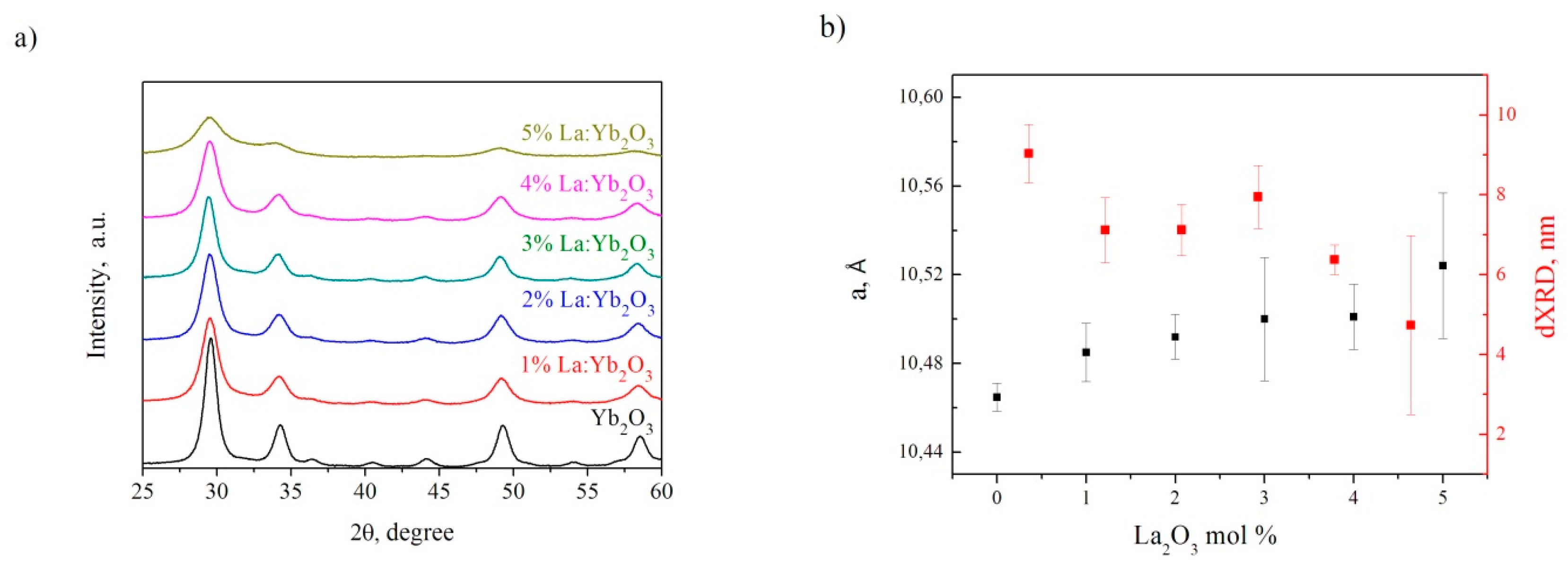
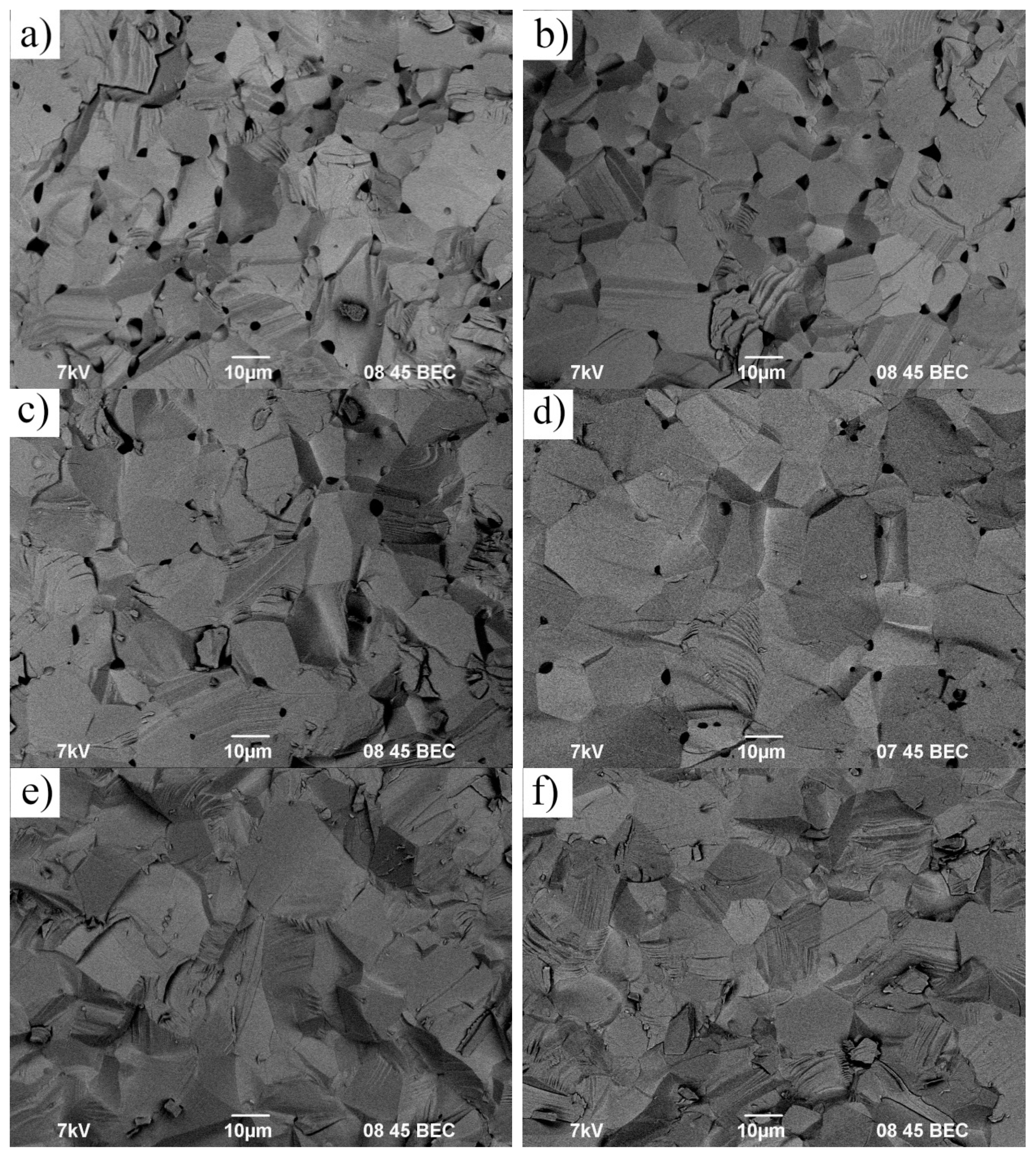
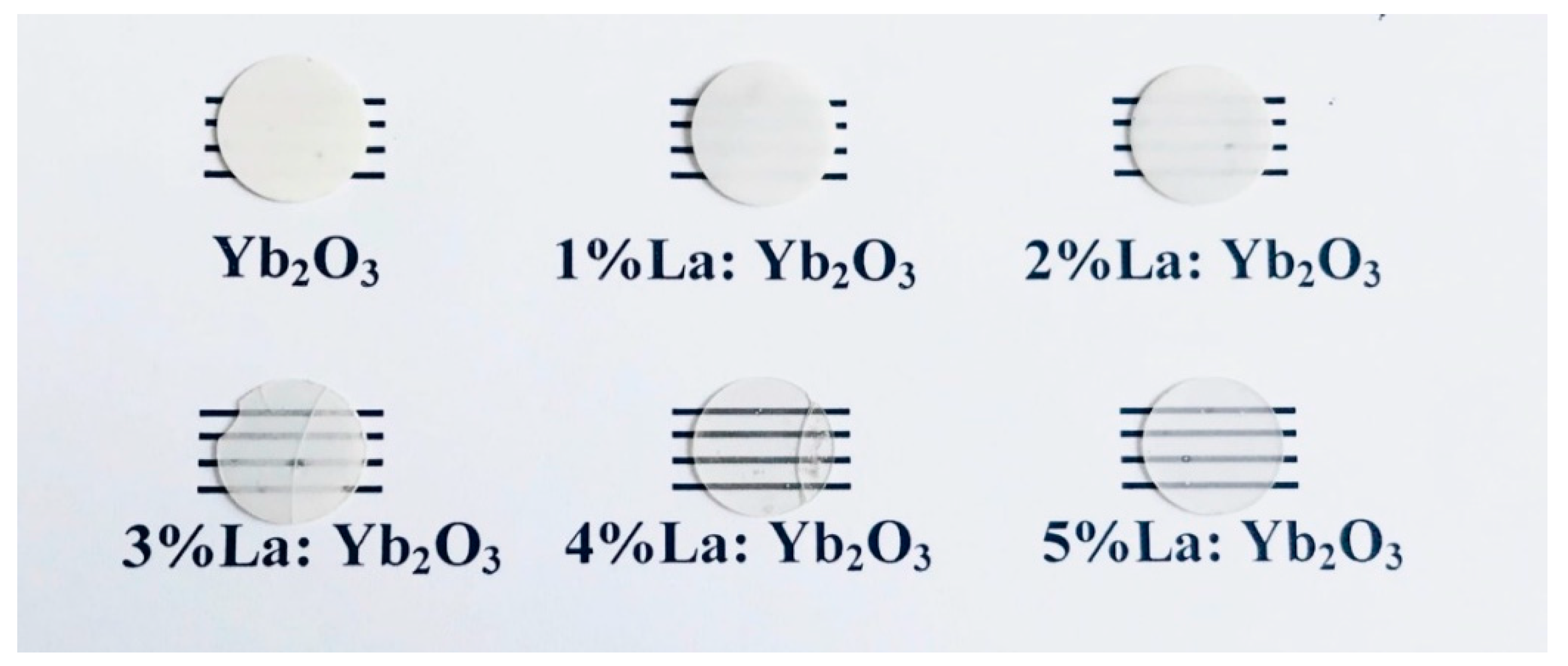

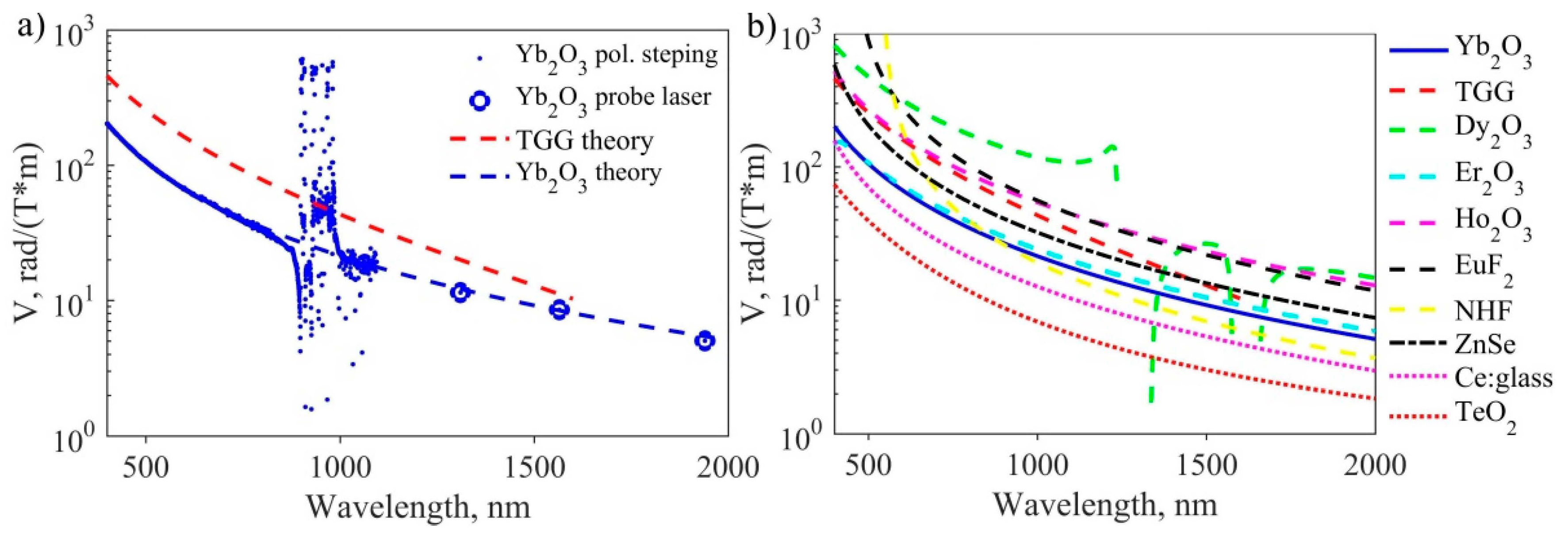
Publisher’s Note: MDPI stays neutral with regard to jurisdictional claims in published maps and institutional affiliations. |
© 2020 by the authors. Licensee MDPI, Basel, Switzerland. This article is an open access article distributed under the terms and conditions of the Creative Commons Attribution (CC BY) license (http://creativecommons.org/licenses/by/4.0/).
Share and Cite
Permin, D.A.; Novikova, A.V.; Koshkin, V.A.; Balabanov, S.S.; Snetkov, I.L.; Palashov, O.V.; Smetanina, K.E. Fabrication and Magneto-Optical Properties of Yb2O3 Based Ceramics. Magnetochemistry 2020, 6, 63. https://doi.org/10.3390/magnetochemistry6040063
Permin DA, Novikova AV, Koshkin VA, Balabanov SS, Snetkov IL, Palashov OV, Smetanina KE. Fabrication and Magneto-Optical Properties of Yb2O3 Based Ceramics. Magnetochemistry. 2020; 6(4):63. https://doi.org/10.3390/magnetochemistry6040063
Chicago/Turabian StylePermin, Dmitry A., Anastasia V. Novikova, Vitaly A. Koshkin, Stanislav S. Balabanov, Ilya L. Snetkov, Oleg V. Palashov, and Ksenia E. Smetanina. 2020. "Fabrication and Magneto-Optical Properties of Yb2O3 Based Ceramics" Magnetochemistry 6, no. 4: 63. https://doi.org/10.3390/magnetochemistry6040063
APA StylePermin, D. A., Novikova, A. V., Koshkin, V. A., Balabanov, S. S., Snetkov, I. L., Palashov, O. V., & Smetanina, K. E. (2020). Fabrication and Magneto-Optical Properties of Yb2O3 Based Ceramics. Magnetochemistry, 6(4), 63. https://doi.org/10.3390/magnetochemistry6040063





